Feb 20, 2025 – Day 4 of the 100 Day Dharma Talk, 3rd Open Dharma Talk, JTS General Meeting, Eco Buddha General Meeting
Hello. Today is the fourth day of Venerable Pomnyun Sunim’s 100-Day Dharma Talk. The third Open Dharma Talk on the topic of “Yebulmun” (Homage Text) continued.
After completing his morning practice and meditation, Sunim headed to the Peace Foundation. Today is the day when he meets with North Korea experts once a month to review the current situation in North Korea and discuss peace on the Korean Peninsula.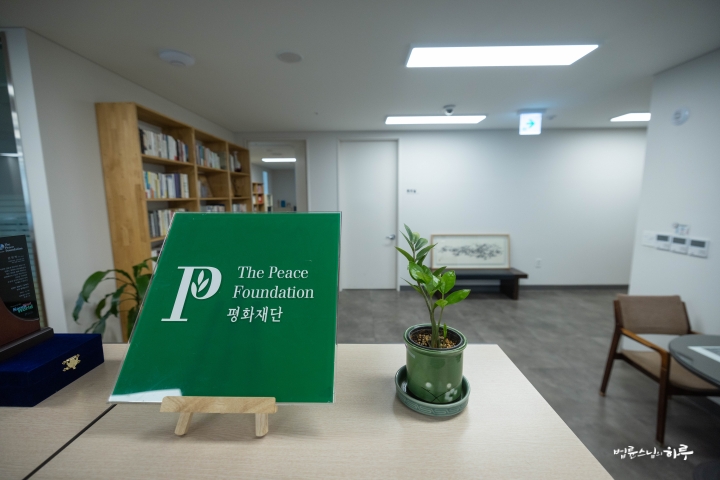
After having breakfast together, they examined the living conditions of North Korean residents and checked changes in exchange rates and food prices. They discussed various topics, including changes in the international situation due to Trump’s re-election and prospects for North Korea-US relations.
After seeing off the North Korea experts, Sunim headed to the third-floor Dharma hall to give the 100-Day Dharma Talk. In the Dharma hall, they were preparing to welcome the audience after diligently performing the 9 a.m. prayer service.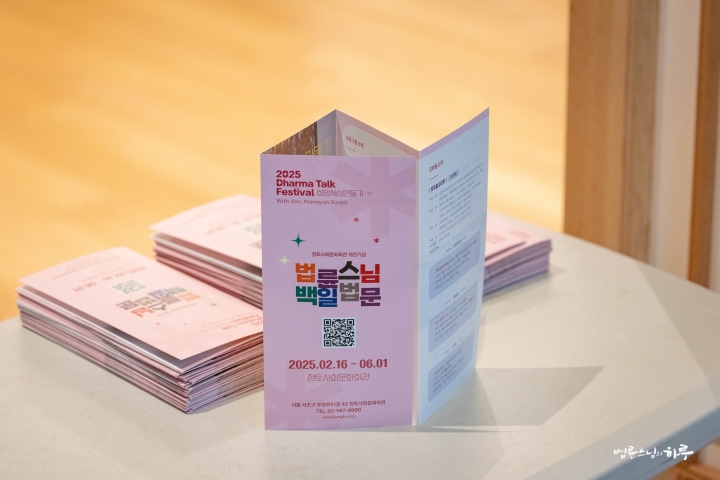
With about 170 people in attendance, they requested a Dharma talk from Sunim with three bows. This is the final session on learning about “Yebulmun,” the first lecture topic of the 100-Day Dharma Talk. Sunim explained in detail “who are the bodhisattvas, the ten great disciples, and the wise teachers of the past whom we worship and revere” in the Yebulmun.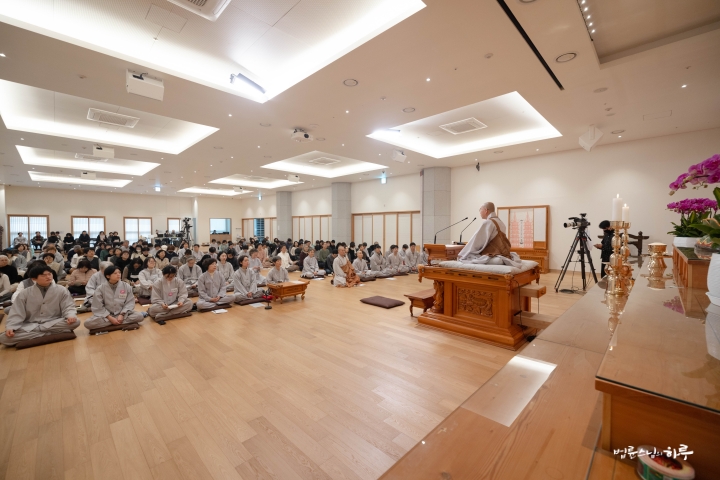
“With utmost sincerity, I take refuge in the Great Wisdom Bodhisattva Manjusri, the Great Action Bodhisattva Samantabhadra, the Great Compassion Bodhisattva Avalokitesvara, and the Great Vow Bodhisattva Ksitigarbha
This sentence is about “taking refuge in the Sangha jewel.” The Sangha jewel includes sravakas, pratyekabuddhas, and bodhisattvas. Korean Buddhism is both Mahayana Buddhism and Seon Buddhism. Therefore, we first take refuge in the Mahayana bodhisattvas, then in the Hinayana sravakas and pratyekabuddhas, and finally in the successive patriarchs of Seon Buddhism.
Mahayana consists of the bodhisattva sangha, which includes ordained practitioners (bhikkhus and bhikkhunis) and lay practitioners (upasakas and upasikas). In other words, it consists of bodhisattvas and the fourfold assembly. According to the Diamond Sutra, a bodhisattva refers to “one who has given rise to the mind of anuttara-samyak-sambodhi.” It means a good man or woman who has vowed to attain enlightenment and realize nirvana. In contrast, the Hinayana sangha consists of five groups of ordained practitioners: bhikkhus, bhikkhunis, sramaneras, sramanerikas, and siksamanas.
So this sentence is about taking refuge in Mahayana bodhisattvas, among which the four great bodhisattvas are considered the most important. They are Manjusri Bodhisattva, foremost in wisdom; Samantabhadra Bodhisattva, foremost in practice; Avalokitesvara Bodhisattva of great compassion; and Ksitigarbha Bodhisattva, who made great vows. The content is about taking refuge in these four bodhisattvas along with all other bodhisattva mahasattvas. Mahasattva also means “one who has given rise to a great mind,” so it has the same meaning as bodhisattva.
With sincere devotion I take refuge and pay homage. At that time on Vulture Peak, receiving Buddha’s entrustment were the Ten Great Disciples, Sixteen Arhats, Five Hundred Arhats, solitary cultivating saints, up to one thousand two hundred great Arhats, and countless compassionate holy beings.
Here, “Vulture Peak” (Gridhrakuta) is a sacred mountain. The phrase “at that time on Vulture Peak during the Buddha’s time” refers to the historical period when Buddha taught there. “Receiving the Buddha’s entrustment” means receiving the Dharma from the Buddha along with the prediction, “You will become a Buddha in the future.” In the Diamond Sutra, there’s a scene where Subhuti stands up and praises the Buddha, saying, “It is rare, World-Honored One! The Tathagata well protects and entrusts all bodhisattvas.” Here, “entrustment” means “to entrust with a request” and signifies “transmitting the Dharma.” 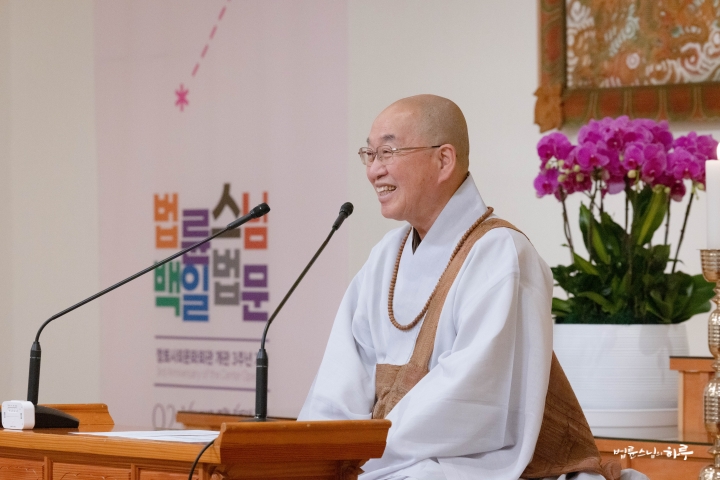
The Ten Great Disciples Who Received the Dharma from the Buddha
The ten great disciples refer to the top disciples among tens of thousands of sravaka disciples who received the Dharma from the Buddha on Vulture Peak.
The first is Sariputra, foremost in wisdom. He is also called Sariputra for short. He was older than the Buddha. Originally a disciple of Sanjaya, he took refuge in the Buddha’s teachings after meeting him. When Sariputra took refuge, the Buddha was only 35 years old and had not yet formed his sangha. The Buddha’s religious experience and practice were shorter compared to the great teachers of that time. However, when someone like Sariputra, who was older, more experienced, and widely known in the world, took refuge in the Buddha’s teachings and became his disciple, the Buddha also became famous quickly. Thus, the first disciple was Sariputra, foremost in wisdom.
The second is Maudgalyayana, foremost in supernatural powers. Maudgalyayana was exceptionally skilled in supernatural abilities. He was later called Venerable Maudgalyayana. Sariputra and Maudgalyayana were friends and both were disciples of Sanjaya. Sariputra first encountered the Buddha’s teachings and took refuge, then brought Maudgalyayana to listen to the Dharma, after which Maudgalyayana also took refuge. These two became the first and second disciples, essentially the two pillars of the sangha. However, since they were older than the Buddha, they passed away before the Buddha entered nirvana. Therefore, after the Buddha’s parinirvana, Mahakasyapa became the most senior disciple. 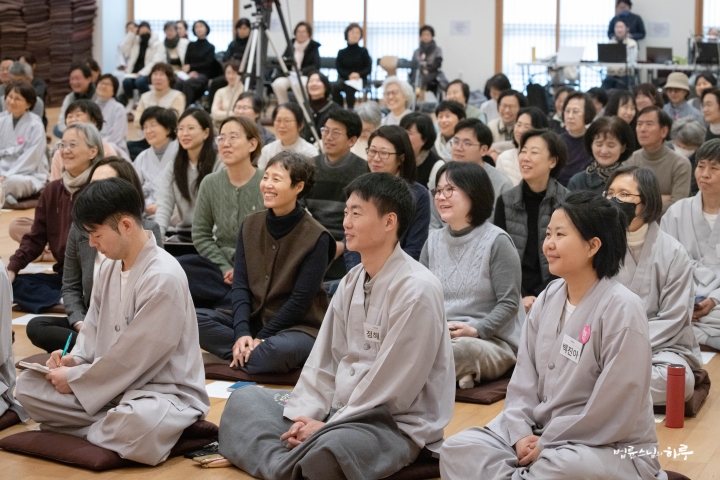
The third is Mahakasyapa, who was foremost in ascetic practices (dhuta). Among the practitioners of his time, Mahakasyapa lived the most frugally. He wore only tattered robes, always slept under trees, and only accepted food from poor households, refusing invitations. This practice of minimizing eating, sleeping, and clothing is called dhuta practice. Those who engage in dhuta practice are much needed in our current era of global environmental crisis. However, these practitioners tend to have an odor. (Laughter) This is because they don’t bathe or wash their clothes. As a result, they were often ostracized even among fellow alms-seekers. When others would say, “He’s dirty. Stay away from him,” and keep their distance from Mahakasyapa, the Buddha would say, “Mahakasyapa, come here,” and offer him half of his own seat. The Buddha then declared, “Mahakasyapa is my equal.” Because of this connection, Seon Buddhism considers Mahakasyapa to have inherited the Buddha’s Dharma.
However, when the Buddha was about to enter parinirvana, he did not designate any specific person as his successor. There are anecdotes where the Buddha directly addressed this issue. When Devadatta said, “I will be the Buddha’s next successor,” the Buddha replied, “Devadatta, a successor is not necessary.” He added, “Even if one were needed, aren’t Sariputra and Maudgalyayana here?” When the Buddha was entering parinirvana, Ananda was worried about succession. The Buddha told him, “Ananda, there is no need for a successor. Each person has attained enlightenment, so everyone will live well on their own.” However, in Seon Buddhism, it is believed that the Dharma was transmitted from mind to mind, or “isim jeonsim.” Therefore, Seon Buddhism considers that the Buddha transmitted the Dharma to Mahakasyapa. 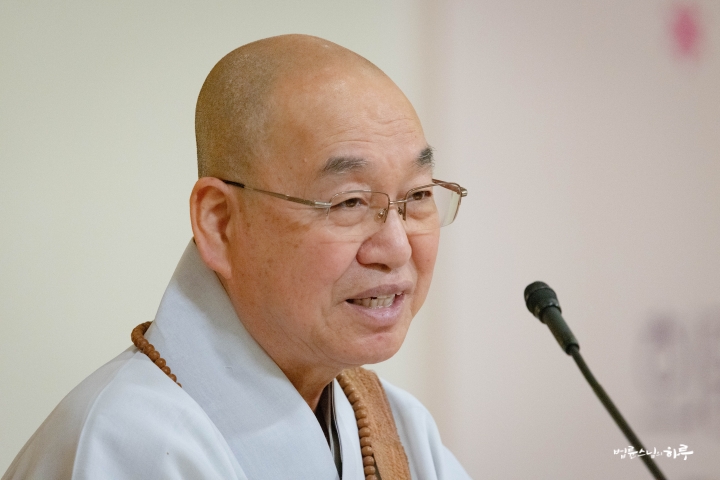
The fourth is Anuruddha, who was foremost in divine eye (dibba-cakkhu). Anuruddha, also known as Aniruddha, was a prince of the Shakya clan. When the Buddha returned to his hometown after 12 years to give a Dharma talk, Anuruddha was deeply moved by his teachings. At that time, seven princes who were close companions all decided to become monks after hearing the Buddha’s discourse. Among these princes, Anuruddha was the most outstanding. One day, while the Buddha was giving a Dharma talk, Anuruddha kept nodding off. The Buddha pointed out that a practitioner should not be drowsy. Anuruddha immediately reflected on this and from that moment on, he stopped sleeping altogether. His eyes became so inflamed that Jivaka, a renowned physician of the time, examined Anuruddha’s eyes and advised the Buddha, “Venerable Aniruddha must sleep. Otherwise, he will go blind.” The Buddha called Anuruddha and said, “The eyes feed on sleep. You should rest.” However, Anuruddha continued his practice without sleeping and eventually lost his eyesight. Although he lost his physical eyes, he gained the divine eye in return. This is why Anuruddha is known as the foremost in divine eye.
There’s an interesting anecdote about Anuruddha that has been passed down. After losing his sight, Anuruddha found daily life challenging. One day, he was trying to mend a torn robe but couldn’t thread the needle. He thought if he could just get the thread through the needle, he might be able to sew the robe by feeling his way around. But he couldn’t get the thread into the needle at all. So Anuruddha said, “If anyone wants to make merit, please come and thread this needle for me.” Someone came and threaded the needle for him, and that person turned out to be the Buddha himself. Anuruddha asked, “Others need to make merit, but don’t you, Buddha, no longer need to accumulate merit?” The Buddha replied, “That’s not so. I, more than anyone, need to accumulate the most merit.” 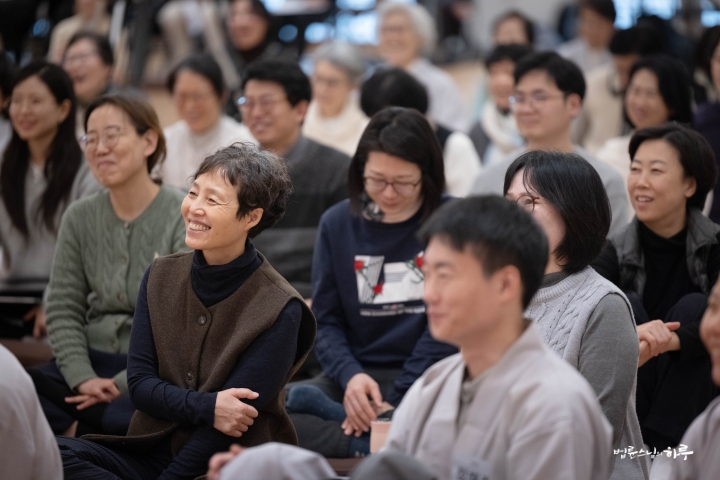
The fifth is Subhuti, known as the foremost in understanding emptiness (解空). He is also called Subhūti.
The sixth is Katyayana, foremost in debate (論議). Since arguing is about asserting one’s own correctness, the Buddha advised against debating with anyone. As there is no right or wrong in the original dharma, the Buddha never engaged in debates throughout his life. However, people from the world constantly sought him out to argue. They came of their own accord, debated, and invariably left defeated. After the Buddha entered nirvana, heretics seized the opportunity to challenge the Buddhist teachings. It was then that Katyayana, without backing down, defeated all the heretics and earned the title of foremost in debate. Katyayana is called ‘Kaccāyana’ in Indian. 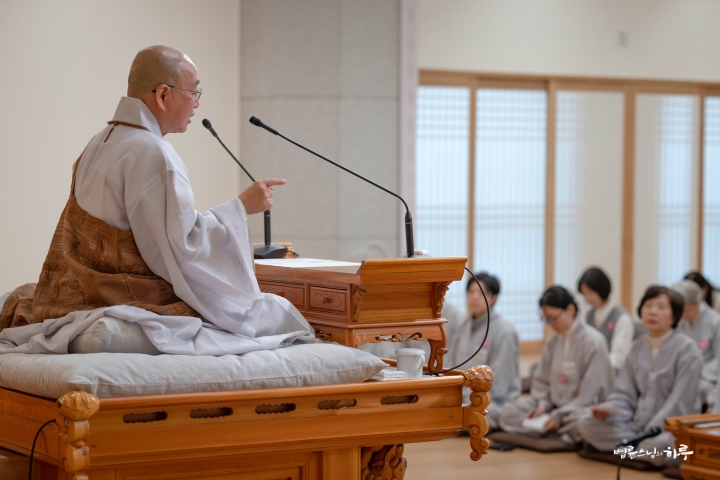
The seventh is Purna, foremost in preaching the dharma (說法). He is said to have converted an impressive 99,000 people through his excellent preaching.
The eighth is Upali, foremost in upholding the precepts (持戒). Upali, originally a barber, followed the Buddha’s teachings and observed the precepts most faithfully. Remember the seven Shakya princes who became monks together? At that time, the Sangha was not yet fully established. While Sariputra was providing some basic training for novices, many details were not yet settled, such as who would shave the heads of new monks. So when the seven princes went to become monks, they had to go to a barber to have their heads shaved. This barber was Upali. After Upali shaved their heads, the princes went to Sariputra to receive the precepts and then to pay respects to the Buddha. Upali was a lower-caste person, essentially a slave who shaved the heads of the Shakya clan. After shaving the princes’ heads, they removed all their ornaments and said, “Take these!” as they renounced the world. Despite their high status, wealth, and families, they discarded everything without hesitation to become monks. This made Upali question his own life, having nothing himself. So he decided to become a monk too. Upali’s decision to renounce the world was not inspired by hearing the Buddha’s teachings, but by observing the princes’ actions. Not knowing whom to approach, he went directly to the Buddha. While Sariputra would provide basic training before allowing someone to become a monk, the Buddha could immediately recognize a person’s potential. He said, “Come, bhikkhu!” and immediately ordained Upali. Thus, Upali entered the Sangha before the princes. 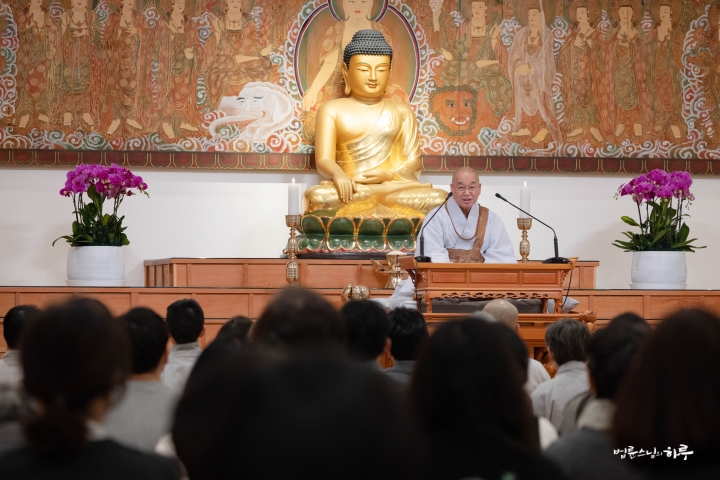
As the princes received their precepts and paid respects to their seniors in order, they noticed Upali, who until recently had been their servant, standing at the end of the line. They found it difficult to bow their heads to him. This led to them being scolded by the Buddha. This is the background of the story where the Buddha says, “Bow to Upali!”
“There are four castes in the world, but not in my Dharma. Just as there are four rivers in the world, but they become one in the ocean, in my Dharma there is only one law.”
Upon hearing these words from the Buddha, the princes immediately erased their worldly notions and bowed to Upali.
Generally, people with little knowledge follow instructions precisely. They do exactly as they’re told. However, once they acquire a bit of knowledge, they start to use their own judgment and take shortcuts. After the Buddha’s parinirvana, while Ananda, who had heard the most of the Buddha’s teachings, drafted the sutras (經), Upali drafted the vinaya (律). He is called the foremost in observing the precepts because he adhered to them so well. 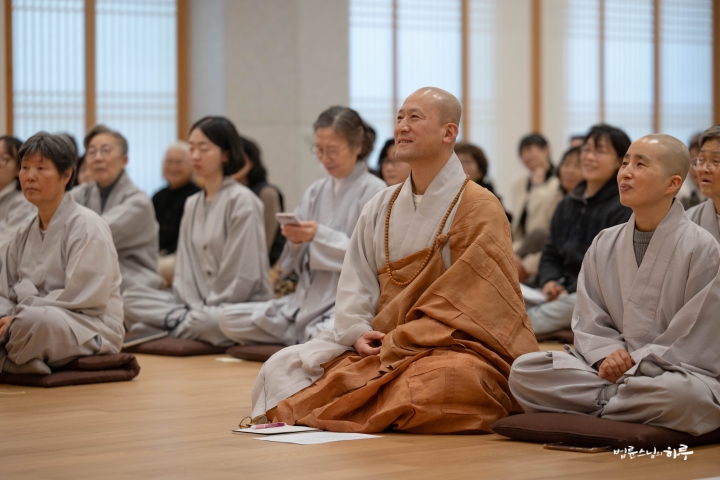
The ninth is Rahula, foremost in secret practice (密行). Secret practice refers to practicing quietly without anyone knowing. Among those who practiced quietly and secretly, Venerable Rahula was the foremost. That’s why in esoteric Buddhism, he is regarded as the Buddha’s successor and considered very important. Rahula was the Buddha’s son. The Buddha returned to his hometown after 12 years of leaving home, upon the invitation of King Suddhodana. The king came out far from the palace to welcome the Buddha. As a parent, how joyful he must have been to see his son return after 12 years. So his parents, siblings, and even his son came out to welcome the Buddha, but there was one person who couldn’t join the welcoming procession – his wife. Since the Buddha was now a practitioner, it wouldn’t have been appropriate for his wife to go out to welcome him. After the Buddha left home, his wife was the one who suffered the most. While her husband was practicing austerities in the forest for six years, she couldn’t live comfortably at home eating and dressing well. So, whether she wanted to or not, she lived frugally with a heavy heart. Although the scriptures never express her resentment towards her husband, there is one passage that reveals her feelings. When the Buddha arrived, Yasodhara, his wife, said to their son Rahula, who was 12 years old at the time:
“That man over there is your father. Go and greet him. After greeting him, ask him for your inheritance.”
Don’t you sense the discomfort in her words to her son? The Buddha had renounced everything, so he had nothing to give. It was as if she was saying, “Let’s see what he has to say.” When the son went to the Buddha and said what his mother had told him to say, the Buddha looked at his son’s face for a long time and then said to Sariputta, who was standing nearby:
“Sariputta, have this child ordained.”
He gave him the greatest inheritance. This is how Rahula came to join the Sangha. However, since a young child had joined the Sangha, many people gossiped due to Rahula’s mischief. The Buddha silently listened to these complaints, and one day he called Rahula and quietly explained to him, using examples, how harmful the consequences of his actions could be. Eventually, after hearing the Buddha’s words, Rahula deeply reflected and no longer caused trouble, practicing diligently and quietly in secret. This is how he became foremost in secret practice. 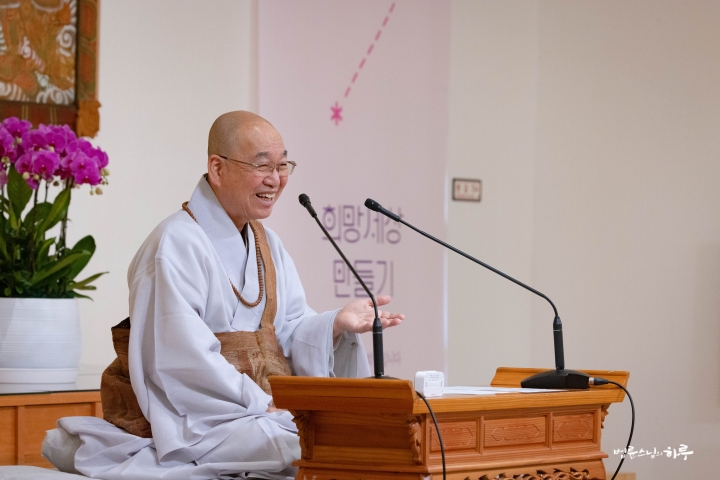
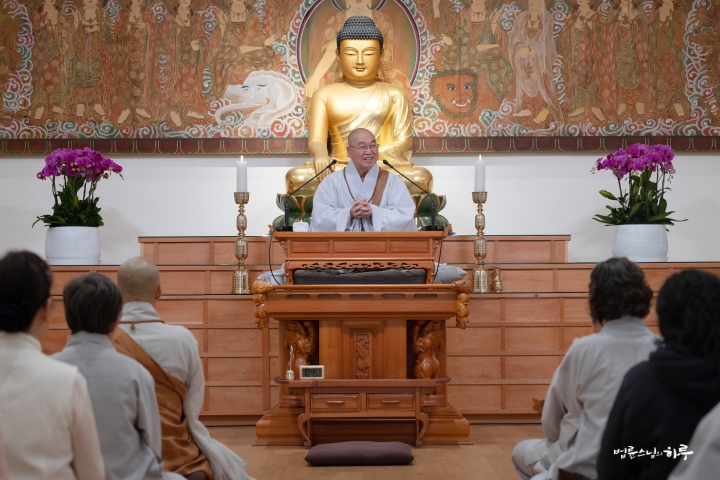
The tenth is Venerable Ananda, foremost in hearing the Dharma. He was the one who heard the most Dharma teachings. When the Buddha was about to enter parinirvana, Ananda wept with sorrow. The Buddha called Ananda to comfort him, saying, “Ananda, for the past 25 years, you have served me as faithfully as the tongue in one’s mouth.” This shows how well Ananda attended to the Buddha’s wishes.
Muryangjabisongjung (無量慈悲聖衆) refers not only to these ten great disciples but to all enlightened beings with immeasurable compassion. Therefore, this phrase means “We bow to all enlightened beings, including the ten great disciples.” 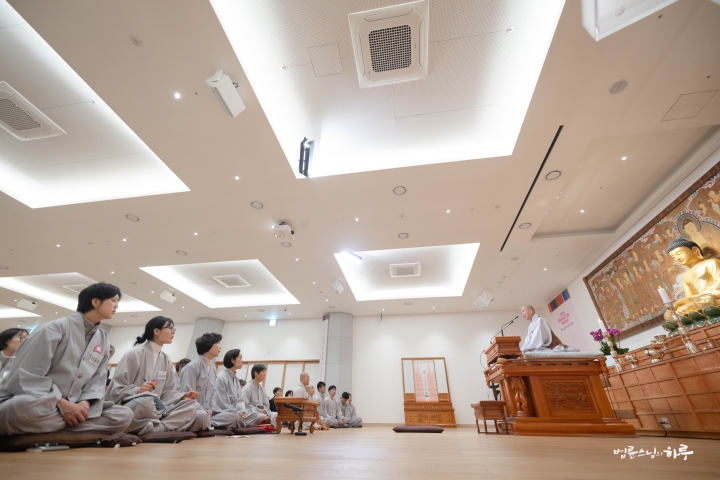
After explaining the last verse of the homage text, Sunim concluded the third session of the Open Dharma Talk as it was approaching noon.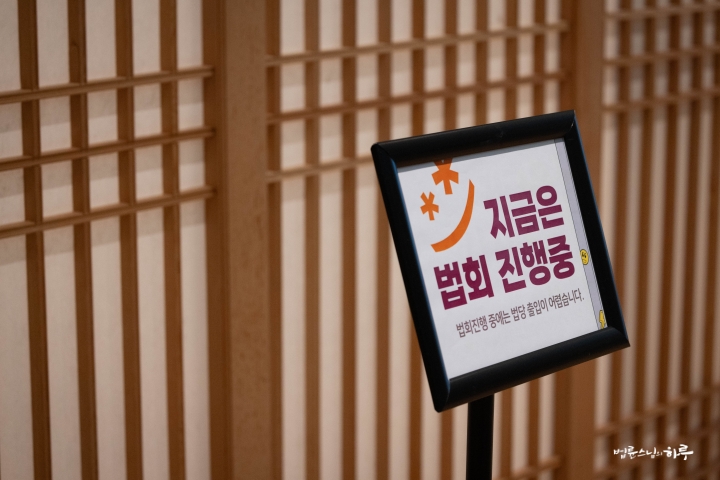
The participants gathered in groups to share their thoughts, while Sunim left the Dharma hall. After lunch, the JTS general meeting began at 1 PM in the 10th-floor conference room.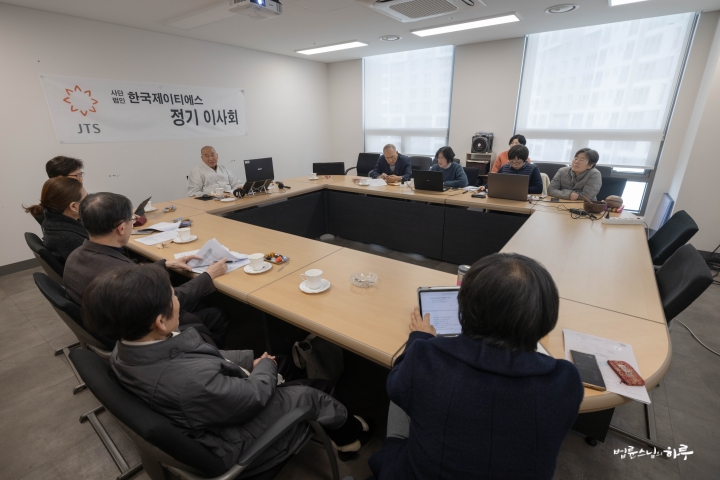
JTS is an organization founded by Sunim in 1993 to combat international hunger, disease, and illiteracy. Some board members attended the meeting in person at the conference room, while others participated online. Sunim, as the chairman of the board, began with opening remarks.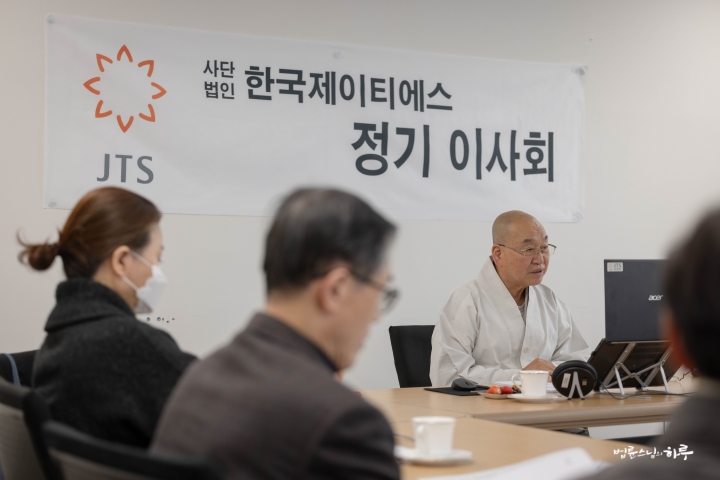
“Thank you all for your hard work over the past year. Thanks to the successful fundraising efforts of JTS Korea and JTS USA, we were able to carry out our activities without financial concerns. There have been many support activities around the world. We continued our ongoing support in India and the Philippines. In India, we carried out projects for hospitals, schools, and village development, while in the Philippines, we expanded our efforts and completed the construction of 10 schools. I would like to express my gratitude to all the staff working in the field.
I believe our greatest achievement last year was building a school for 4,000 students in the Turkish border region of Syria. Beyond simple humanitarian aid, this project may play a very positive role in establishing diplomatic relations between Korea and Syria in the future. Additionally, we provided significant support to flood-affected areas in Pakistan and expanded our humanitarian aid to the Rohingya refugee camps in Cox’s Bazar, Bangladesh. 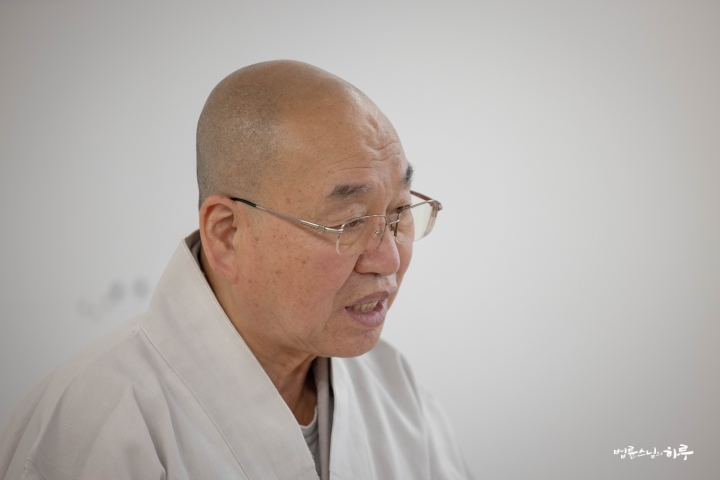
Last year, we initiated a new sustainable development project in Bhutan, and the pilot program progressed smoothly without major issues. In Sri Lanka, support activities were successfully carried out in collaboration with local residents. Along the Thai border, aid was provided to Myanmar refugees. We constructed an orphanage dormitory in Thailand and completed a girls’ dormitory in Cambodia. Domestically, support was extended to marginalized groups. Many such large and small projects have been ongoing. I would like to take this opportunity to express my gratitude to everyone who participated in these activities.
This year, our operations are expected to expand further. The Bhutan project will begin in earnest, and we plan to build 12 schools in the Philippines. If humanitarian aid to North Korea resumes, our activities will likely expand even more. With the end of the Syrian civil war, there’s also a possibility that JTS may need to provide support across Syria. I ask for your continued dedication and hard work this year as well.” 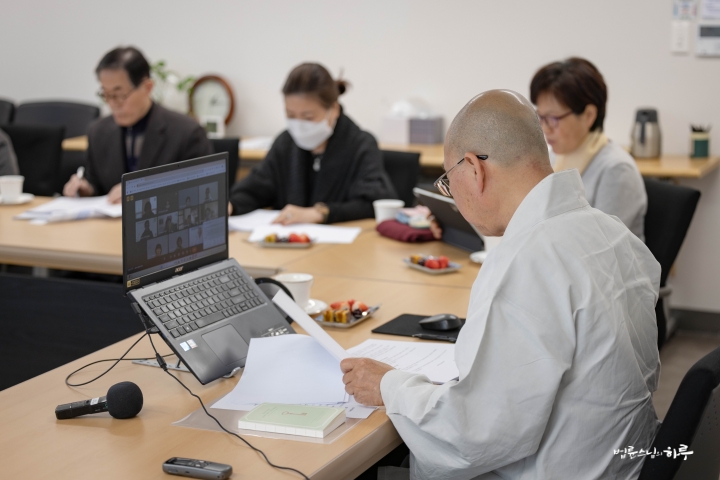
Following this, there was a review and Q&A session on the 2024 business report and settlement, as well as the 2025 business plan and budget proposal.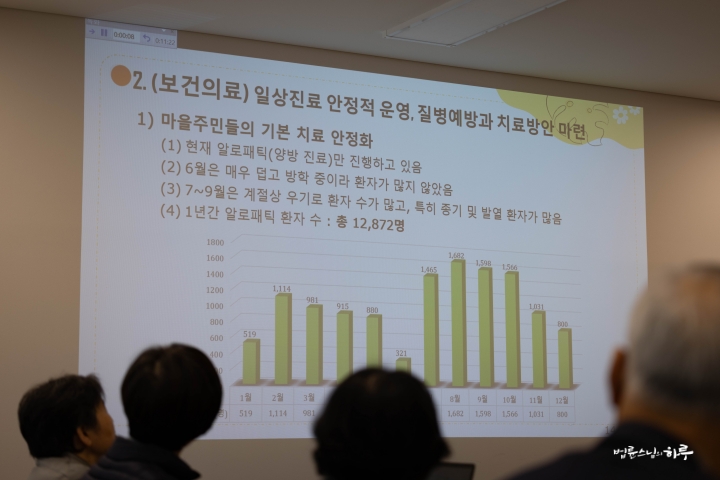
After a thorough Q&A session, the business plan was unanimously approved, and the JTS board meeting concluded with a round of applause.
At 3 PM, the Eco Buddha board meeting began. Sunim, as the chairman of Eco Buddha, gave the opening remarks. He emphasized that the climate crisis is not just a problem for specific regions but a global phenomenon, and that Eco Buddha should become an organization that seeks alternative lifestyles in response to this crisis.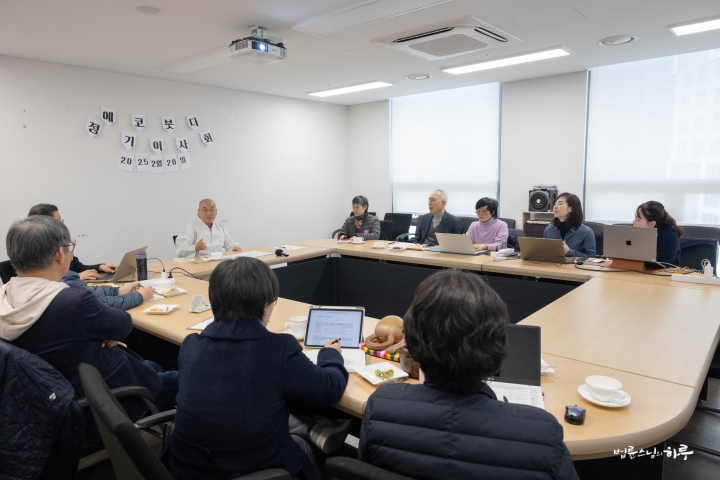
“Thank you all for your hard work over the past year. This year, in particular, the damage caused by the climate crisis seems to be even more severe. In Los Angeles, California, wildfires and floods are occurring simultaneously. In the past, droughts and floods occurred separately, but now we’re seeing unusual phenomena where they occur consecutively or simultaneously in the same area. 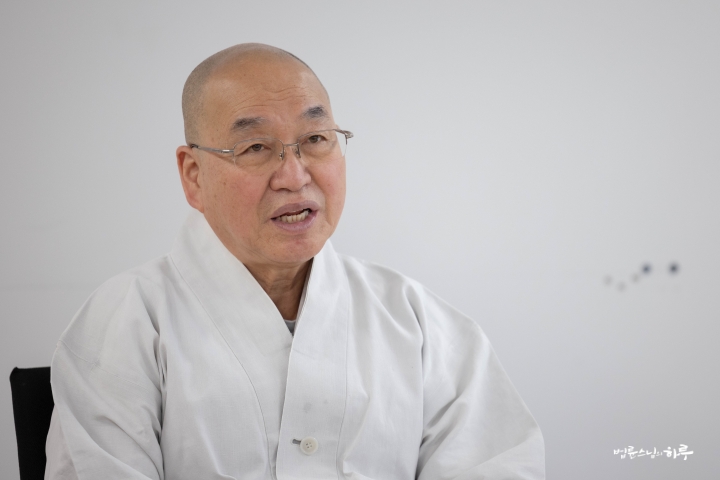
To Spread Alternative Lifestyles in the Era of Climate Crisis
In Bhutan, water sources are gradually disappearing. One might say, ‘Is it because we’re using too much water?’ But the fact is that water sources are actually decreasing. Bhutan is a country with well-preserved forests, so we can’t say ‘it’s because trees were cut down in the mountains,’ and there hasn’t been any special development either. Nevertheless, the shortage of drinking water is becoming serious. Ultimately, this climate crisis can be seen as a global phenomenon, not just a problem for specific regions. In this situation, I hope Eco Buddha will become an organization that contributes to exploring alternative lifestyles in the era of climate crisis.”
Following this, the head of Eco Buddha’s environmental team reported on the main activities of 2024.
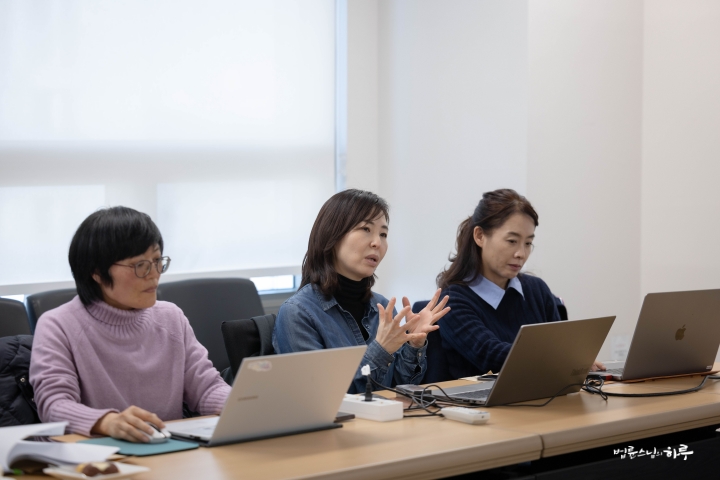
“Last year, Eco Buddha operated various educational programs such as Climate School, Zero Waste School, and Eco Cinema, with 1,457 participants and high satisfaction rates. We also conducted pilot programs to expand waste reduction practices nationwide and spread a culture of reduced consumption through sharing and emptying markets. 912 people participated in the policy environment workshop, and in particular, the youth branch workshop discussed ways to reduce consumption and create a safe environment.”
In the subsequent report on the 2025 business plan, the key directions for this year were explained.
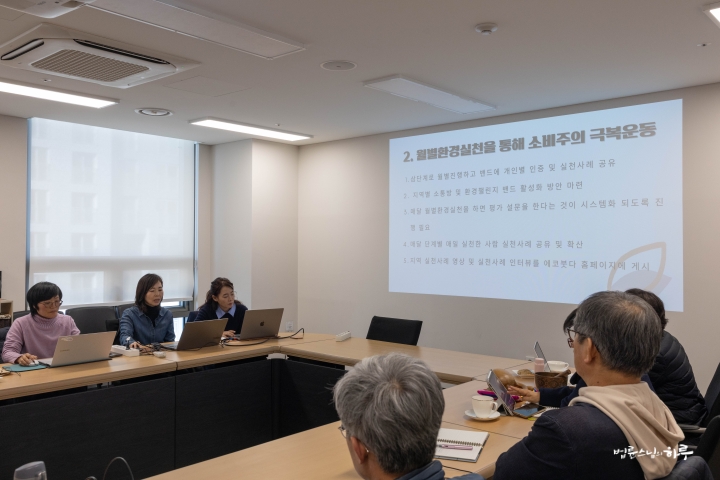
“This year, we plan to strengthen education for regional group leaders to expand the Climate School and launch a full-scale consumption reduction practice movement. 100 experimental participants will record their daily consumption and minimize their lifestyle by keeping only essential consumption items. Through this, we plan to create a practical consumption reduction model. We also plan to establish a zero-waste practice model and improve the operation of sharing and emptying markets to expand participation. In addition, we will supplement the monthly environmental practice system and establish new research projects to overcome the climate crisis and propose policies for sustainable living.”
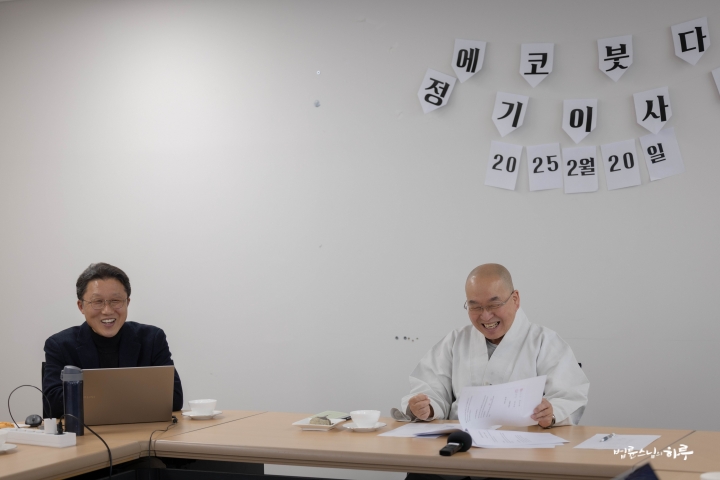
After the report, there was a Q&A session. Sunim pointed out the reality that eco-friendly facilities are not sufficiently prepared within Jungto Society, and suggested that a sewage treatment facility should be installed as a pilot project at the Mungyeong Retreat Center to establish a practical environmental practice model. He also mentioned that consideration should be given to expanding such facilities beyond mere experiments to be applicable in regions like Bhutan.
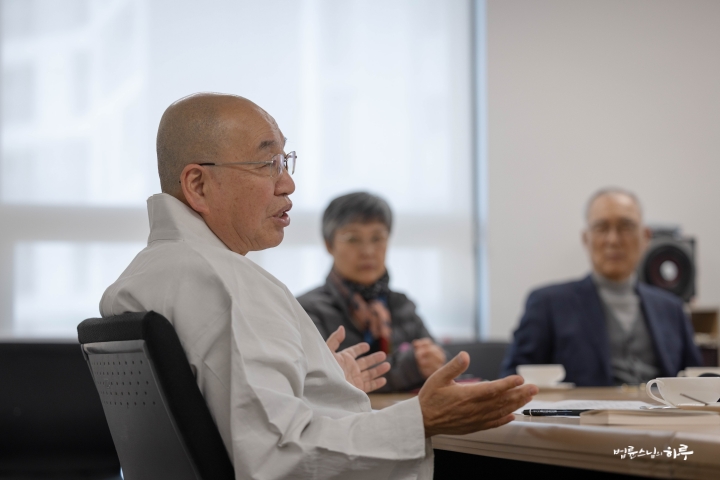
One of the board members then stated that when discussing environmental issues, a perspective that considers non-human life forms and future generations must be included. Given that there are recent arguments within the environmental movement for establishing a ‘Future Generation Citizens’ Department’ to review the future impact of policies, it was suggested that Jungto Society should also reflect this perspective in all decision-making processes.
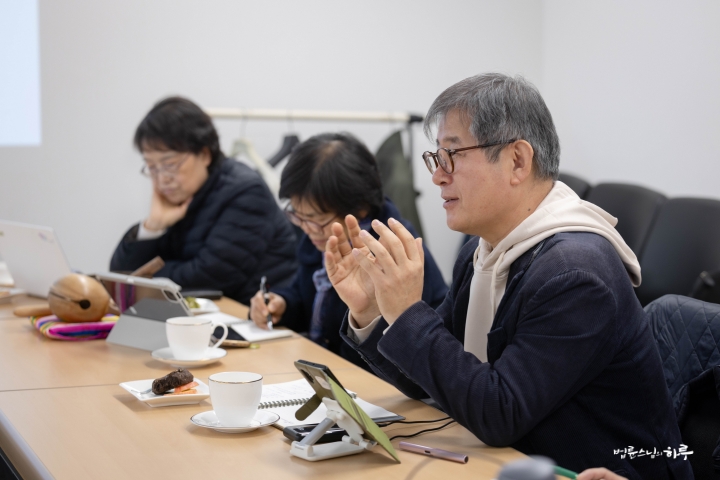
Finally, the 2024 audit report and 2025 budget proposal were reviewed, and there were recommendations for Sunim’s resignation as chairman and new board members. Sunim encouraged the Eco Buddha secretary general and activists for their hard work throughout the year and concluded the board meeting with applause.
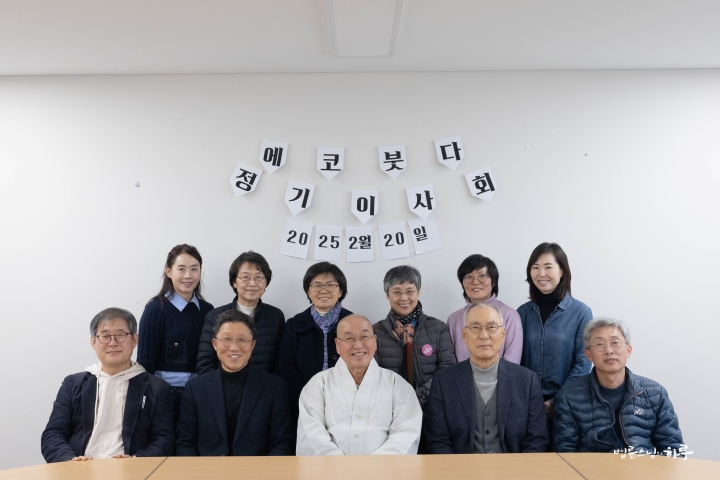
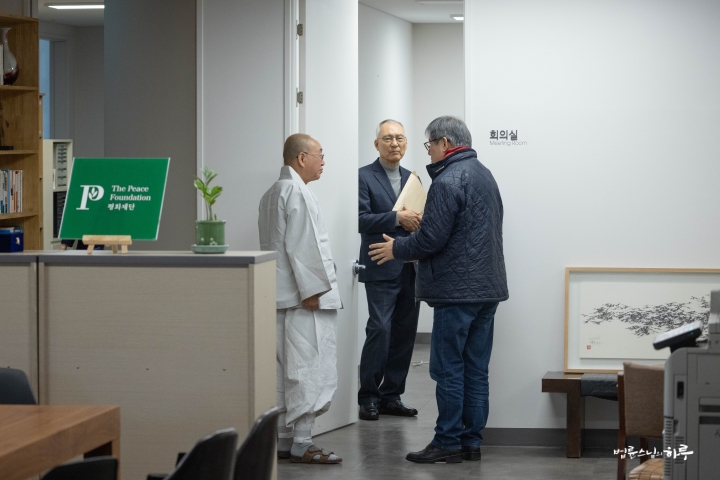
As the sun set, the third Open Dharma Talk for evening session members began at 7:30 PM.
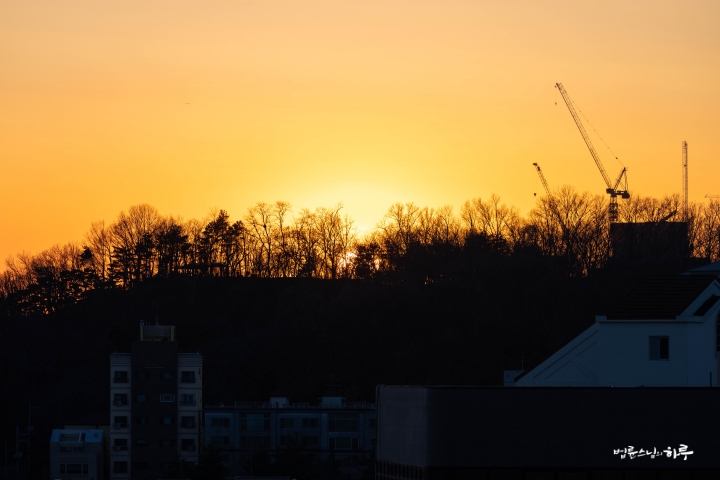
With about 120 people gathered in the third-floor Dharma hall, Sunim began his Dharma talk. He continued the explanation of the chanting text on the same topic as the morning Dharma talk. Today, he completed the explanation up to the last verse of the chanting text.
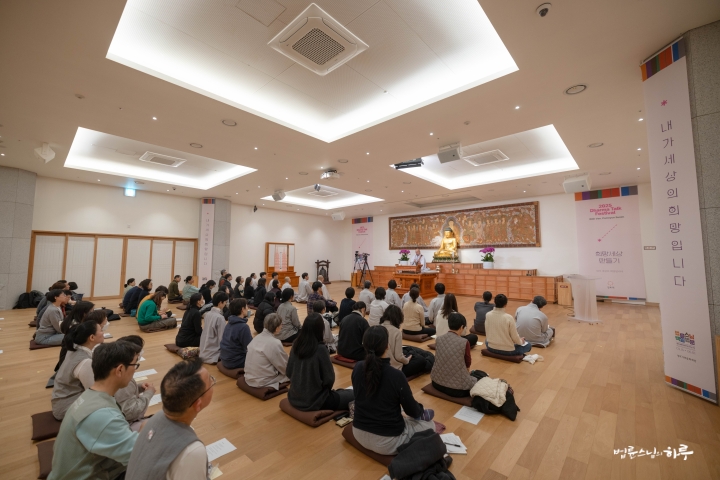
“With sincere devotion I take refuge and pay homage to all the great ancestral teachers who transmitted the lamp of Dharma from India to China and to our Eastern Sea (Korea), to the patriarchs of all schools under heaven, and to all the great spiritual guides as numerous as particles of dust.
“Korean Buddhism is both Mahayana Buddhism and Seon Buddhism. In Seon Buddhism, those who transmit the Dharma from mind to mind are called ‘patriarchs’ (josa). Seon Buddhism claims that in addition to the sutras that verbally transmitted the Buddha’s teachings, there is also a transmission of the Dharma from mind to mind. This is called ‘transmission from mind to mind’ (isim jeonsim). Because it is said to have transmitted the Dharma separately from words, it is called ‘a special transmission outside the scriptures’ (gyooe byeonjeon). 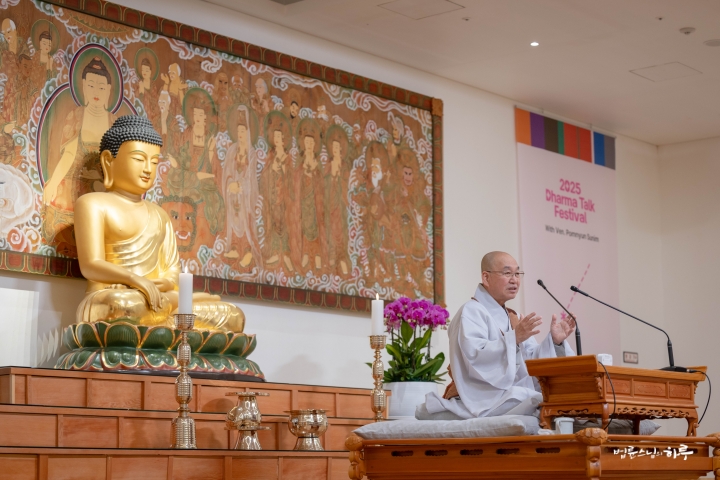
How Could the Buddha’s Teachings Have Reached Me Today?
First, Mahakasyapa received the Dharma from the Buddha through mind-to-mind transmission. Second, Ananda inherited the Dharma, and third, Venerable Sanakavasa received it, continuing until the 28th patriarch, who was Bodhidharma. When Bodhidharma crossed from South India to China and stayed at Shaolin Temple, the one who inherited the Dharma was the second patriarch, Huike. Huike’s Dharma was passed to the third patriarch Sengcan, Sengcan’s to the fourth patriarch Daoxin, Daoxin’s to the fifth patriarch Hongren, and Hongren’s to the sixth patriarch Huineng.
With the sixth patriarch Huineng, Seon Buddhism spread rapidly throughout China. So, rather than the name Huineng, the title ‘Sixth Patriarch’ became more famous, and the collection of his teachings is called the Platform Sutra of the Sixth Patriarch. Despite not being the words of the Buddha, it is called a ‘sutra’. In Seon, Huineng’s words are considered so important that they are not simply called ‘the teachings of the Sixth Patriarch’, but the Platform Sutra of the Sixth Patriarch or the Dharma Jewel Platform Sutra. 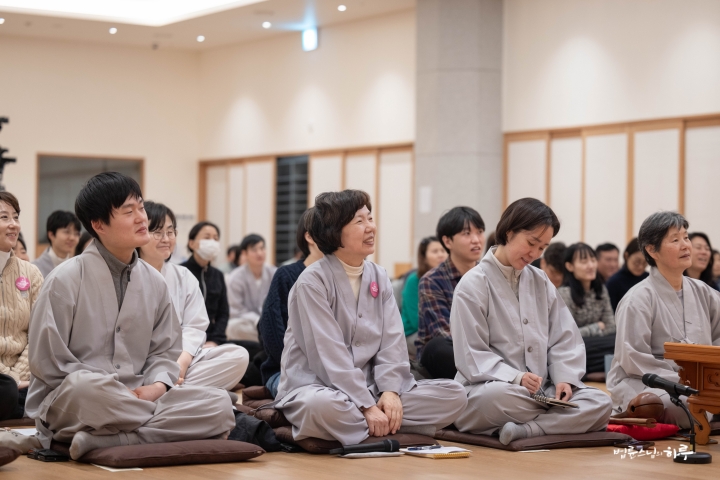
This Dharma lineage continued until the 56th patriarch, Seokokcheonggong (石屋淸珙). At the end of the Goryeo Dynasty, the Korean Seon master Taego Bowoo (太古普愚) inherited the Dharma in China and became the 57th patriarch. Thus, the Dharma was transmitted through 28 generations in India, then 28 generations in China, before being passed on to Haedong Joseon (Korea). This lineage continued to the 75th patriarch, Master Yongseong Jinjong, and continues to this day. The successive Dharma lamp transmission (歷代傳燈) refers to all the great patriarchs (諸大祖師) who have passed on the lamp of Dharma throughout history. To date, there have been 78 successive patriarchs (歷代祖師) who have transmitted the Dharma.
In addition to the patriarchs, there have been eminent teachers in each era who were revered as great masters of the world and became heads of their respective schools (宗). These include Great Master Wonhyo (元曉), Great Master Uisang (義湘), and Vinaya Master Jajang (慈藏), among many other great teachers. These are referred to as the great masters of the world (天下宗師).
In the phrase “all the great spiritual teachers as numerous as dust particles” (一切微塵數 諸大善知識), “dust particles” (微塵) refers to extremely fine particles of dust. Therefore, this phrase means “great spiritual teachers as numerous as the fine particles of dust in the universe.” 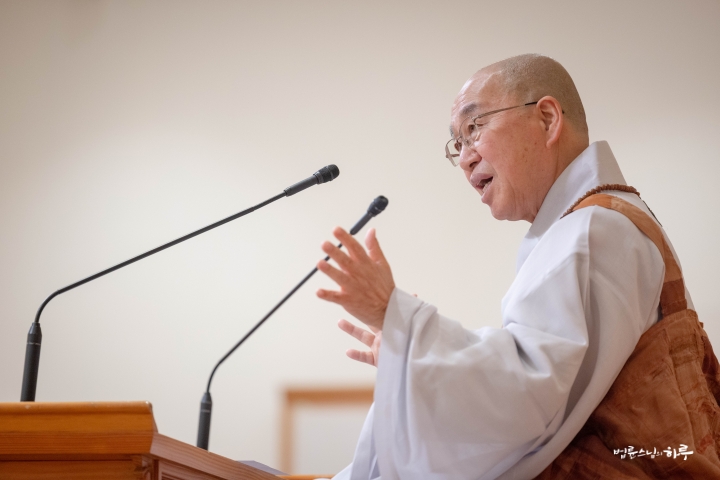
Thus, the Buddhist chanting ritual can be described as a ceremony of paying homage to the Mahayana bodhisattvas, the Hinayana sravakas and pratyekabuddhas, as well as the lineage of Seon Buddhist patriarchs and numerous wise teachers. It is all about taking refuge in the Sangha jewel.
With utmost sincerity I take refuge and bow to all the Sangha assemblies dwelling permanently throughout the ten directions and three times in the net-like realm of countless worlds.
This means taking refuge in all teachers, as there are countless masters in this world. After offering the Five-Part Dharma Body Incense (obunyeobsin-hyang), seven prostrations are performed to take refuge in the Three Jewels (sambo). Finally, a vow is made.
Oh, Endless Three Jewels! Please accept my prostration and bestow your blessings upon me.
I pray that all sentient beings, without distinction between self and others, may attain enlightenment at the same time. 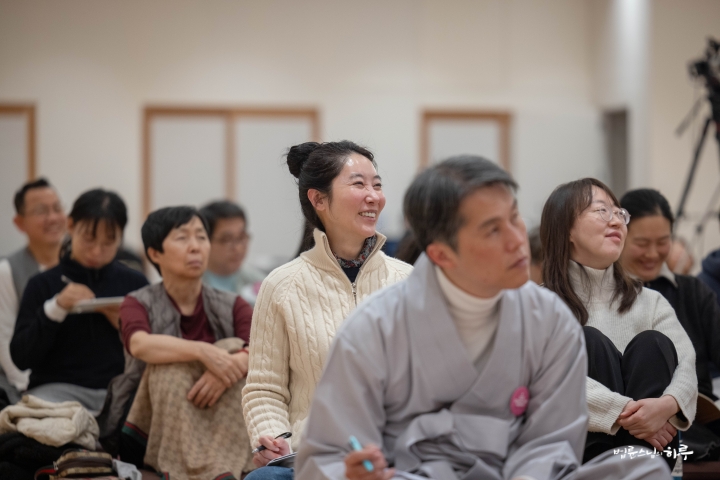
This is how we conclude the chanting ritual with sincere vows. In Buddhism, when we pray diligently, give to others, or do any good deed, it is said that we “accumulate merit.” At such times, we should not think, “I have accumulated merit, so I alone should receive the benefits!” Instead, we must dedicate this merit back to all sentient beings. This is called “dedication of merit” (hoehyang). Therefore, when we accumulate a lot of merit by doing good deeds, we always vow to dedicate it at the end. 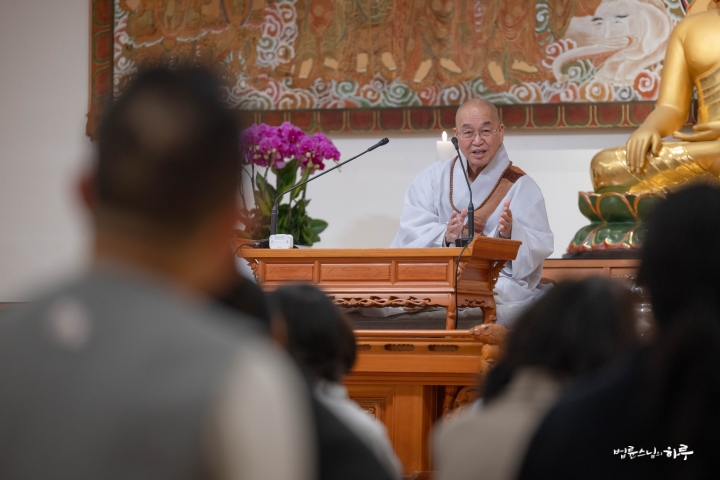
“I dedicate all the merit accumulated today to all sentient beings. May the hungry be fed, the sick be healed, children receive proper education, and may all those who suffer be freed from their suffering.”
This is how we make a vow of “dedication of merit.” It is about dedicating the merit of our chanting not just to ourselves, but to all beings in this world, wishing for everyone to attain enlightenment together. We should perform the chanting ritual with such earnest intentions. Don’t just keep bowing your head to the ground; your heart should bow as well. When you cultivate a mind of respect and praise, your heart will naturally bow. When you hear the Ten Epithets of the Tathagata (Yeorae Sipho), don’t you feel like praising the Buddha? This act of praising, respecting, worshipping, and making offerings is what chanting is about. Chanting is not about begging the Buddha, saying, “Please grant my wish.”
After delivering a Dharma talk for an hour and 30 minutes, Sunim concluded the lecture on the chanting text after 9 PM.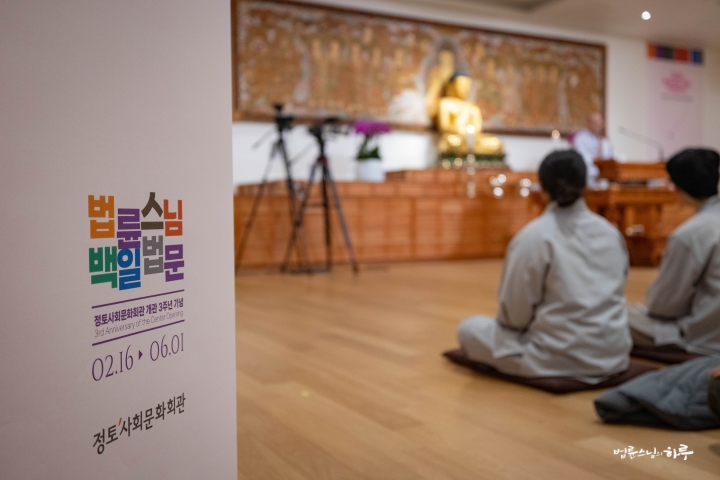
After listening to the lecture on the chanting text, when reading it again, each phrase resonated more deeply in my heart.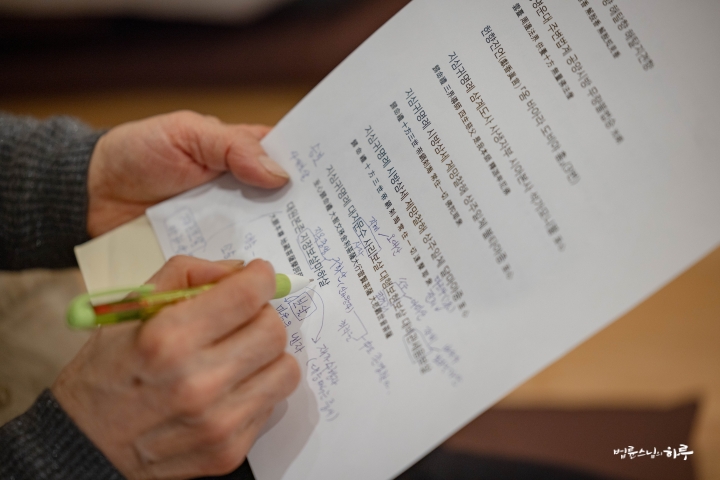
The participants gathered in groups to share their thoughts, while Sunim returned to the Jungto Center to wrap up the day’s activities and retire for the night.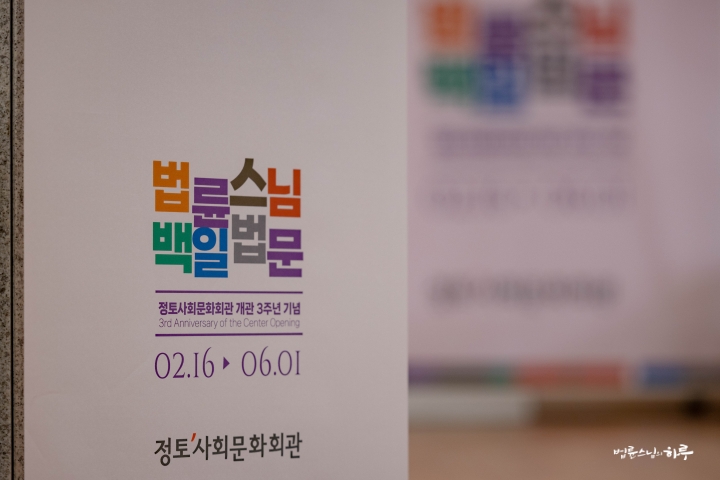
Tomorrow, Sunim is scheduled to give Dharma Q&A lectures in the morning and evening at the basement auditorium of the Jungto Social and Cultural Center. In the afternoon, he will attend the Peace Foundation board meeting and the general assembly of the incorporated association.””




